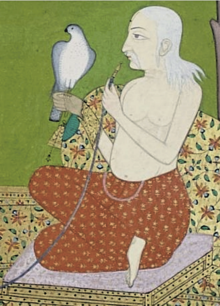This article needs additional citations for verification. (September 2024) |
| Shahu I | |
|---|---|
| Maharaj Hindupati Padshah[citation needed] | |
 Shahu I holding a falcon by Shivram Chitari c.1750 | |
| Chhatrapati of the Marathas | |
| Reign | 12 January 1708[1] –15 December 1749[2][3] |
| Coronation | 12 January 1708, Satara[4] |
| Predecessor | Shivaji II |
| Successor | Rajaram II |
| Peshwa | |
| Born | Shivaji Sambhaji Raje Bhosale 18 May 1682 Mangad Fort, Maratha Kingdom[5] (present-day Mangaon, Maharashtra, India) |
| Died | 15 December 1749 (aged 67)[6] Rangmahal Palace, Satara, Maratha Confederacy[6] (present-day Maharashtra, India) |
| Spouse | |
| Issue |
|
| House | Bhonsale |
| Father | Sambhaji |
| Mother | Yesubai[8] |
| Religion | Hinduism |
| Signature |  |
Shahu I (Shivaji Sambhaji Raje Bhonsale; Marathi pronunciation: [ʃaːɦuː]; 18 May 1682 – 15 December 1749) was the fifth Chhatrapati of the Maratha Confederacy founded by his grandfather, Shivaji I. He was born into the Bhonsle family, and was the son of Sambhaji I and Yesubai. At a young age, he was taken into custody at the Siege of Raigad by Mughal emperor Aurangzeb, and held captive. He was released from captivity after the death of Aurangzeb in the hope of engineering an internecine struggle among the Maratha factions of Tarabai and Shahu. Shahu emerged victorious in the bloody Battle of Khed and was crowned as Chhatrapati.
Under the reign of Shahu, Maratha power and influence extended to much of central and western India, which had then created a strong Maratha Confederacy. After his death, his ministers and generals such as the Peshwa Bhats and their lieutenants of the Shinde and Holkar house, Senasahibsubha Bhonsles of Nagpur, and Senakhaskhel Gaikwad of Baroda administered their own sections of the confederacy under a loose coalition under the orders of the Chhatrapati.
- ^ Pī. E. Gavaḷī (1988). Society and Social Disabilities Under the Peshwas. National Publishing House. p. 5.
At last Shahu emerged victorious and ascended the throne at Satara on 12th January, 1708.
- ^ Mehta 2005, p. 314.
- ^ Rameshwarprasad Ganeshprasad Pandey (1980). Mahadji Shinde and the Poona Durbar. Oriental Publishers & Distributors. p. 3.
Chhatrapati Shahu Maharaj ruled for about forty-two years from January 12, 1708, to December 15, 1749
- ^ Pī. E. Gavaḷī (1988). Society and Social Disabilities Under the Peshwas. National Publishing House. p. 5.
At last Shahu emerged victorious and ascended the throne at Satara on 12th January, 1708.
- ^ Mehta 2005, p. 51.
- ^ a b Mehta 2005, p. 181.
- ^ a b Mehta 2005, p. 177.
- ^ "Ruka'at-i-Alamgiri; or, Letters of Aurungzebe, with historical and explanatory notes". 1908.